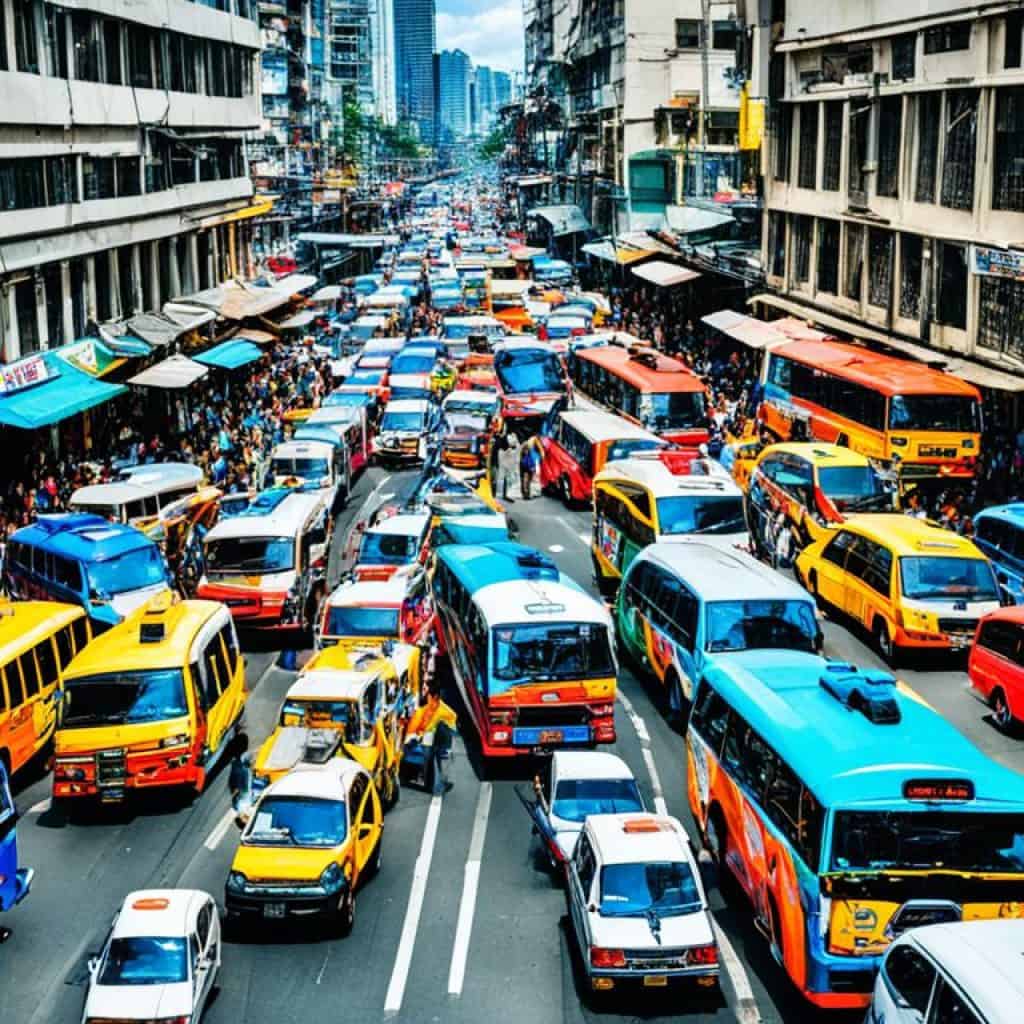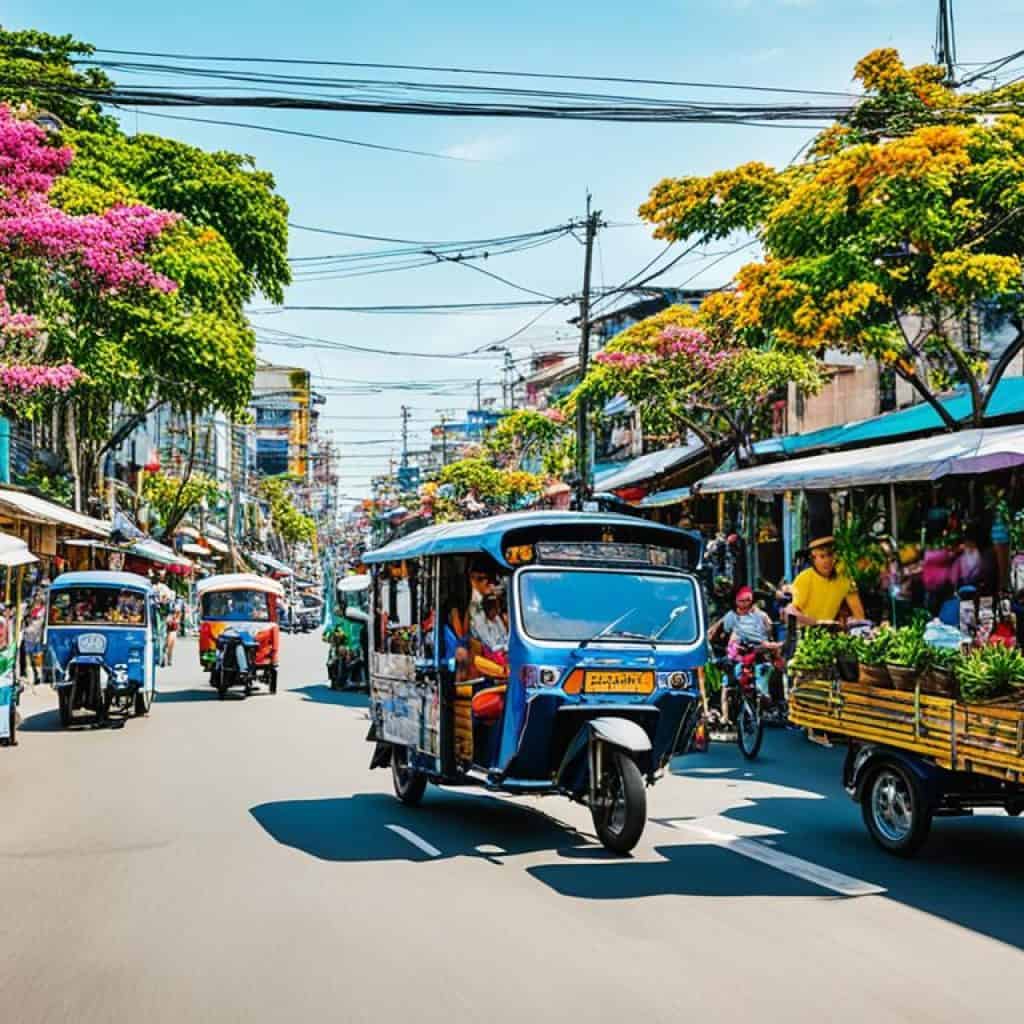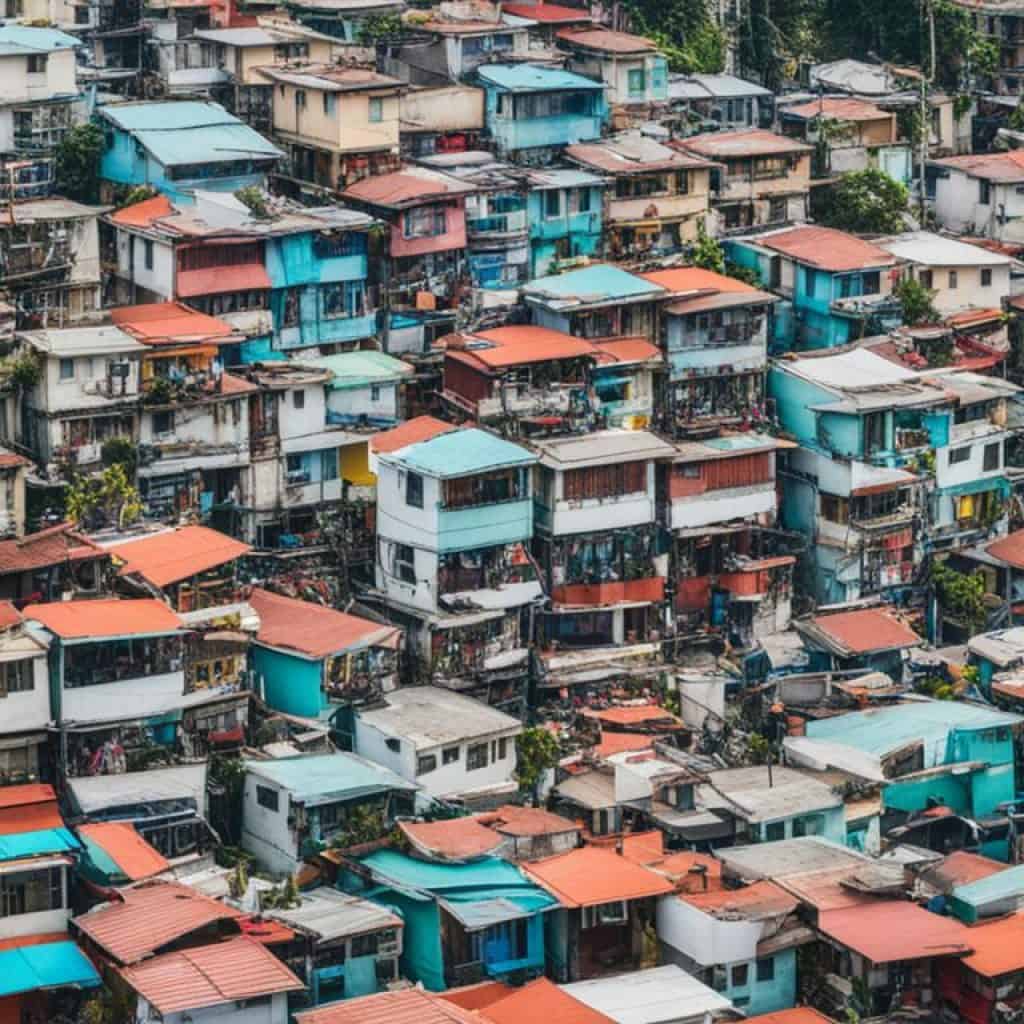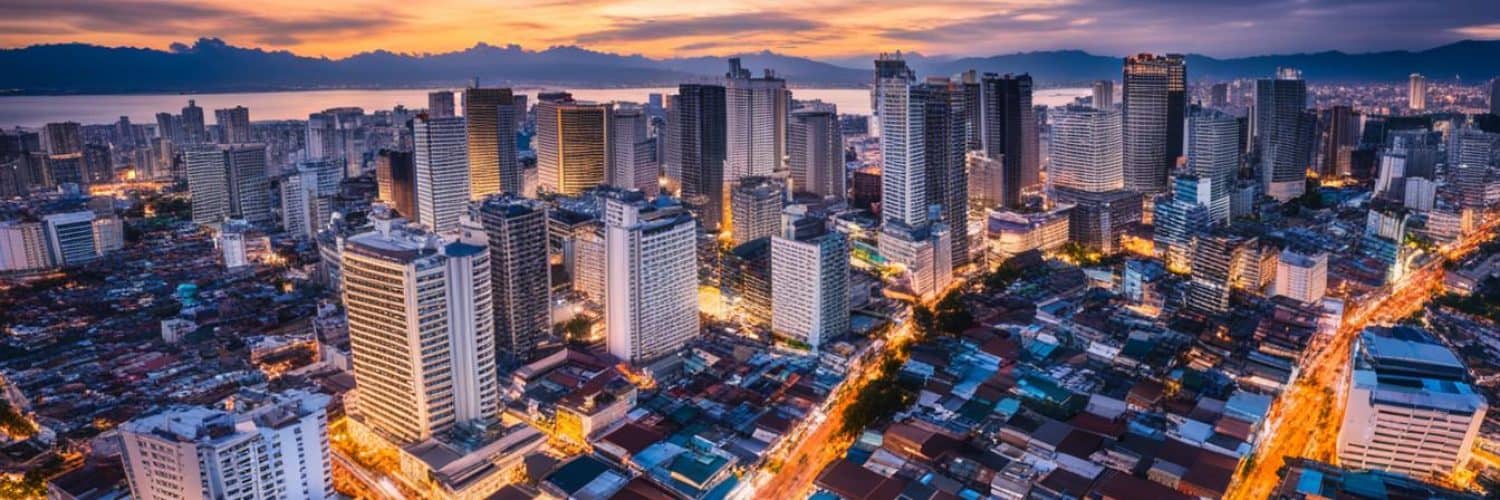Are you ready to embark on a cultural adventure like no other? Imagine living in a city that offers a rich tapestry of history, mouthwatering cuisine, and a warm sense of community. Welcome to Manila, the bustling capital of the Philippines.
With its vibrant city life, diverse attractions, and unique local experiences, Manila has something to captivate everyone. Whether you’re a food enthusiast looking to savor the flavors of Filipino cuisine, a culture buff eager to explore historical landmarks, or a seeker of urban excitement, Manila promises to be a city that will awaken your senses.
Join us as we delve into the fascinating facets of life in Manila. From the bustling streets to the hidden gems, we’ll guide you through the wonders that await you in this vibrant metropolis. Discover the mesmerizing culture, indulge in the mouthwatering food scene, and immerse yourself in the vibrant local lifestyle of Manila.
- Manila offers a vibrant city lifestyle filled with diverse attractions and experiences.
- The city is known for its rich cultural heritage and warm sense of community.
- Manila’s food scene is a treasure trove of mouthwatering flavors and culinary delights.
- Explore the city’s unique attractions, from historical landmarks to modern entertainment.
- Immerse yourself in the vibrant local lifestyle and embrace the warmth of Manila’s locals.
Transportation in Manila
Getting around Manila can be quite challenging due to the notorious traffic, especially during rush hours. Navigating the city’s busy streets can be an overwhelming experience, with drivers often disregarding basic traffic rules. As a result, driving in Manila can be a stressful endeavor.
However, there are alternative transportation options available for expats to get around the city. While importing cars to Manila is only permitted for certain individuals, public transportation offers a viable solution for commuting. Here are some of the transportation modes in Manila:
- Jeepneys: Iconic to Manila, jeepneys are a cheap and traditional mode of transportation. These colorful and uniquely designed vehicles ply various routes, making them accessible to different parts of the city.
- Buses: Manila has a comprehensive bus network that covers major routes. Although buses can be crowded, they offer a convenient way to travel within the city.
- Taxis: Metered taxis are widely available and offer a more comfortable and convenient option for getting around Manila. However, it is advisable to ensure that the meter is used to avoid overcharging.
- Trains: The Light Rail Transit (LRT) and Metro Rail Transit (MRT) are rapid transit systems that provide an efficient way to travel through Manila. They are especially useful for commuting longer distances or avoiding heavy traffic.
Exploring Manila through public transportation can be an adventure in itself. While it may take some time to understand the routes and schedules, it offers an opportunity to experience the city like a local.

Manila’s public transportation system is constantly evolving, with plans for future expansions and improvements. Despite the challenges posed by traffic congestion, the city is working towards enhancing its transportation infrastructure to provide more efficient and convenient options for commuters.
Neighborhoods in Manila
Manila, the bustling capital of the Philippines, is divided into six legislative districts, each with its own unique neighborhoods. These neighborhoods offer a diverse range of residential areas, catering to different preferences and lifestyles. Whether you’re looking for historical charm, convenient access to major roads, or proximity to renowned universities, Manila has something to offer.
Intramuros
Intramuros, also known as the Walled City, is a popular tourist spot that has been transformed into a residential area. This neighborhood is steeped in history and charm, with Spanish colonial architecture and cobblestone streets. Living in Intramuros offers a unique experience, where residents can immerse themselves in the city’s rich cultural heritage.
Ermita
Ermita is a vibrant neighborhood known for its bustling commercial district. Here, you’ll find a mix of offices, businesses, and universities, making it an ideal location for professionals and students alike. With easy access to major roads and transportation hubs, Ermita offers convenience and a lively atmosphere.
Sampaloc
Sampaloc, known as the “University Belt,” is a dynamic district that is home to several renowned universities and educational institutions. This neighborhood attracts a vibrant student community, creating a lively atmosphere filled with energy and opportunities. Sampaloc also boasts convenient bus terminals, ensuring easy access to other parts of Manila.
These are just a few of the many neighborhoods that make up Manila’s diverse residential landscape. Whether you’re drawn to the historical charm of Intramuros, the convenience of Ermita, or the vibrant student life in Sampaloc, there’s a neighborhood in Manila that suits your lifestyle and preferences.

Explore the table below for a summary of the key features of these neighborhoods:
| Neighborhood | Highlights |
|---|---|
| Intramuros | – Rich historical heritage – Spanish colonial architecture – Cobblestone streets – Tourist attractions |
| Ermita | – Commercial district – Offices and businesses – Universities and educational institutions – Easy access to major roads |
| Sampaloc | – “University Belt” – Prominent universities – Lively student community – Convenient bus terminals |
Housing in Manila
When it comes to finding a place to live in Manila, expats have a range of options to choose from. Whether you’re interested in renting or buying, Manila offers a variety of housing choices to suit different preferences and budgets.
Renting a Home
Renting a home is a popular choice among expats in Manila. There are numerous houses, apartments, and condominiums available for rent in different areas of the city. The cost of rental units can vary significantly depending on the location. Generally, units near office blocks or universities tend to be more expensive.
On average, a one-bedroom apartment in Manila costs around â¬200 per month, while a two-bedroom unit costs â¬400 per month. It’s worth noting that utilities like water, gas, and electricity are usually not included in the rental fee and will be an additional expense.
Buying Property
Foreign nationals are allowed to purchase high-rise apartments or condominiums in Manila, but they cannot own land. If you’re considering buying property in Manila, investing in a condo is a popular choice. Condos often come with amenities such as swimming pools, gyms, and 24-hour security.
The Cost of Living in Manila
When deciding on housing in Manila, it’s important to factor in the cost of living. While housing costs can be affordable compared to other major cities, expenses such as transportation, groceries, and healthcare should also be considered.
Average Rental Prices in Manila
Living in Manila offers a diverse range of housing options to suit different lifestyles and budgets. Whether you choose to rent or buy, it’s important to consider your specific needs and preferences. Take the time to research different neighborhoods and consult with real estate professionals to find the perfect place to call home in Manila.

Education in Manila
The education system in Manila is structured according to the K to 12 model, which encompasses kindergarten to grade 12. The Department of Education oversees the primary and secondary years, while the Commission on Higher Education focuses on local universities and graduate schools.
Expatriates residing in Manila have the option to enroll their school-age children in either international schools or local institutions. International schools provide education to students from different nationalities, offering a diverse and multicultural learning environment. There are several renowned international schools in Manila that follow international curricula, including the International School Manila, British School Manila, and German European School Manila.
Manila is also home to prominent universities that cater to higher education. The University of Santo Tomas, founded in 1611, is one of the oldest existing universities in Asia and offers a wide range of undergraduate and graduate programs. De La Salle University, a leading private university, is known for its strong academic programs and research initiatives.
International Schools in Manila
The following table provides an overview of some of the notable international schools in Manila:
| School | Curriculum |
|---|---|
| International School Manila | International Baccalaureate (IB) and American Curriculum |
| British School Manila | British Curriculum leading to IGCSE and A-Levels |
| German European School Manila | German Curriculum leading to the German International Abitur |
| Japanese International School Manila | Japanese Curriculum |
International schools in Manila provide a high standard of education and ensure that students receive a globally recognized education. These institutions often offer diverse extracurricular activities, state-of-the-art facilities, and a supportive learning environment.
Additionally, the Philippine education system places strong emphasis on English proficiency, with English being the primary language of instruction in many schools. This ensures that expatriate students have the opportunity to excel academically while adapting to a new cultural environment.
Healthcare in Manila
When it comes to healthcare in Manila, expats can rest assured knowing that there are high-quality hospitals available in the city. However, it is important to note that a down payment is usually required for medical services.
While healthcare coverage in the Philippines is limited, it is highly recommended for expats living in Manila to have sufficient healthcare insurance coverage. Out-of-pocket spending on medical services in Manila has increased significantly in recent years, making insurance essential for financial protection.
Here are some of the most popular hospitals among expats in Manila:
| Hospital | Location |
|---|---|
| Makati Medical Center | Makati City |
| St. Luke’s Hospital | Quezon City |
| Manila Doctors Hospital | Ermita, Manila |
These hospitals are known for their state-of-the-art facilities and skilled medical professionals, providing comprehensive medical services to both local residents and expatriates.
By prioritizing healthcare insurance and being well-prepared, expats can have peace of mind knowing that they have access to quality medical services in Manila.
Culture and Festivals in Manila
Manila is a city steeped in rich history and vibrant culture, offering a plethora of sights, museums, and festivals that celebrate the essence of Filipino culture. Immerse yourself in the vibrant tapestry of Manila’s cultural scene, where traditions are cherished and celebrated.
Historical Sites: One of the highlights of Manila’s cultural heritage is the iconic San Augustin Church located in Intramuros. Recognized as a UNESCO World Heritage Site, this magnificent church showcases stunning Spanish colonial architecture and holds immense historical significance.
Religious Influence: Manila has a strong Christian influence, evident in the abundance of churches and religious festivals that take place throughout the year. Embrace the spirituality and witness the fervor of the faithful in events such as the Feast of the Black Nazarene, a grand procession that attracts millions of devotees.
Cultural Events and Fiestas: Immerse yourself in the vibrant atmosphere of Manila’s cultural events and fiestas. Experience the pulsating energy of Manila Day, a celebration of the city’s rich heritage, and revel in the grandeur of the colorful parades, music, dance, and pageantry. The city truly comes alive during these festivals, offering a memorable experience for all.
Fascinating Manila Museums
These museums provide a fascinating insight into the diverse cultural heritage of the Filipino people, from pre-colonial times to the present.
Timeless Manila Churches
Manila is dotted with unique and awe-inspiring churches that reflect the deep-rooted religious traditions of the Philippines. Some notable churches in Manila include:
- Manila Cathedral, a symbol of the Catholic faith in the Philippines
- San Agustin Church, a UNESCO World Heritage Site and one of the oldest churches in the Philippines
- Quiapo Church, famous for its annual procession of the Black Nazarene
- Binondo Church, a testament to the rich Catholic heritage of the Filipino-Chinese community in Manila
These magnificent churches not only serve as places of worship but also stand as architectural marvels and cultural landmarks.
Must-Visit Museums and Churches in Manila
| Museums | Churches |
|---|---|
| National Museum of the Philippines | Manila Cathedral |
| Bahay Tsinoy | San Agustin Church |
| Metropolitan Museum of Manila | Quiapo Church |
| Lopez Museum and Library | Binondo Church |
Daily Life in Manila
Daily life in Manila is a vibrant and exciting experience. As the capital city of the Philippines, Manila offers a unique blend of modern amenities and rich cultural heritage. Expats who choose to make Manila their home will encounter a diverse mix of people, cuisines, and activities that contribute to a fulfilling daily routine.
The cost of living in Manila varies depending on factors such as housing, transportation, and entertainment. While some neighborhoods in Manila may have higher rental prices, expats can find more affordable options in other areas. Utilities, groceries, and dining out are generally reasonably priced, allowing for a comfortable lifestyle in the city.
Manila’s tropical weather can be both a blessing and a challenge. Expats should be prepared for warm temperatures and high humidity throughout the year. The city also experiences typhoons and heavy rainfall, which can lead to occasional flooding. However, with the right preparations and awareness, expats can navigate the weather and enjoy the beauty of Manila’s lush landscapes.
Safety is an important consideration in any city, and Manila is no exception. While the city has improved its security measures in recent years, expats should remain vigilant and take necessary precautions. It is advisable to be aware of one’s surroundings, especially in crowded areas and during nighttime. By staying informed and adopting safety measures, expats can navigate Manila with confidence.
Manila offers expats a rich cultural experience and a warm community that embraces diversity. From exploring historical sites and enjoying the local cuisine to immersing oneself in Manila’s vibrant arts and music scene, there are endless opportunities to create meaningful connections and memorable experiences.
| Aspect of Daily Life | Key Considerations |
|---|---|
| Cost of Living | Varies depending on factors such as housing, transportation, and entertainment. |
| Weather | Tropical climate with warm temperatures, high humidity, and occasional typhoons. |
| Safety | Remain vigilant, especially in crowded areas, and take necessary precautions. |
Embracing Manila's Cultural Richness
One of the highlights of daily life in Manila is the city’s vibrant cultural scene. Expats can immerse themselves in local traditions, festivals, and celebrations that showcase the Filipino identity. From exploring historical landmarks such as Intramuros to visiting renowned museums and art galleries, Manila offers a rich tapestry of cultural experiences.
- Experience the religious festivals and processions that highlight Manila’s deep Catholic traditions.
- Sample the diverse culinary delights, from street food to upscale restaurants, that reflect the multicultural influences in the city.
- Engage in the local arts and music scene, with performances ranging from traditional folk dances to contemporary theater productions.
Living in Manila provides expats with a unique opportunity to embrace a dynamic blend of modernity and tradition. With its diverse neighborhoods, vibrant lifestyle, and warm community, Manila offers a daily routine that is both enriching and fulfilling.
Conclusion
In conclusion, Life in Manila offers a vibrant and exciting experience for expats looking to immerse themselves in a rich culture, indulge in delicious cuisine, and explore diverse attractions. The city’s historical sites, such as the iconic Intramuros, provide a glimpse into Manila’s fascinating past and are a must-visit for history enthusiasts.
Manila’s food scene is a melting pot of flavors, with local delicacies and international cuisine available at every corner. From street food to fine dining, expats can embark on a culinary adventure and savor the diverse flavors of the city.
While Manila poses challenges like traffic congestion and healthcare limitations, the warmth and hospitality of the local community make it a welcoming place to call home. The cultural heritage of Manila is celebrated through various festivals, museums, and churches, offering expats a chance to fully immerse themselves in Filipino traditions and customs.
Overall, Life in Manila promises an unforgettable experience filled with vibrant attractions, a dynamic food scene, and a rich cultural tapestry. It is a city that cherishes its past, embraces its present, and looks forward to a bright future. Expats residing in Manila will find themselves enchanted by the city’s charm and captivated by its unique blend of tradition and modernity.
FAQ
What is life like in Manila?
Life in Manila is vibrant and exciting, with a rich culture, delicious food scene, and bustling city attractions. The locals are known for their warm hospitality and humble nature.
How is transportation in Manila?
Getting around Manila can be challenging due to the notorious traffic, especially during rush hours. Driving in Manila can be stressful, with many drivers ignoring basic traffic rules. Public transportation options include jeepneys, buses, taxis, and trains like the Light Rail Transit (LRT) and Metro Rail Transit (MRT).
What are the neighborhoods in Manila?
Manila is divided into six legislative districts, with each district having its own unique neighborhoods. Intramuros, Ermita, and Sampaloc are among the prominent districts of Manila.
What are the housing options in Manila?
Expats can choose to either purchase high-rise apartments or condominiums or rent homes in Manila. The cost of rental units varies depending on the location and size of the unit.
How is education in Manila?
The education system in Manila follows the K to 12 structure, which includes kindergarten to grade 12. Expats have the option to enroll their children in international schools or local institutions. Manila is home to prominent universities such as the University of Santo Tomas and De La Salle University.
What are the healthcare options in Manila?
Manila has high-quality hospitals available for expats, but a down payment is usually required. Healthcare coverage in the Philippines is limited, and it is recommended for expats to have sufficient healthcare coverage. Popular hospitals among expats in Manila include Makati Medical Center, St. Luke’s Hospital, and Manila Doctors Hospital.
What is the culture like in Manila?
What is daily life like in Manila?
Daily life in Manila can be vibrant and exciting, with a diverse culinary scene, cultural events, and fiestas. The cost of living varies depending on factors such as housing, transportation, and entertainment. Expats should be prepared for the tropical weather conditions and take necessary precautions for natural disasters.


















Add comment